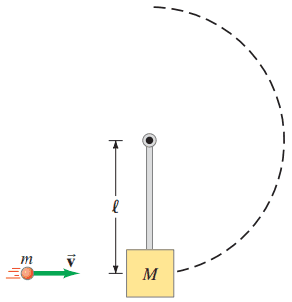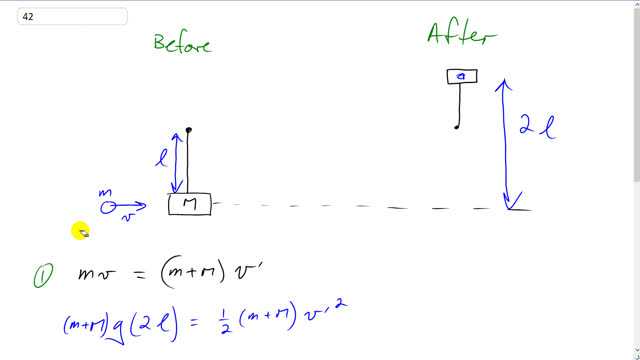
A pendulum consists of a mass hanging at the bottom end of a massless rod of length , which has a frictionless pivot at its top end. A mass , moving as shown in Fig. 7–35 with velocity , impacts and becomes embedded. What is the smallest value of sufficient to cause the pendulum (with embedded mass ) to swing clear over the top of its arc?


In order to watch this solution you need to have a subscription.
This is Giancoli Answers with Mr. Dychko. This bullet of mass, m, is approaching a ballistic pendulum which is initially at rest with mass M and the little bullet is approaching at some speed v and this ballistic pendulum has this rod connected to a pivot of length l and after the bullet hits this mass, we are assuming that this ballistic pendulum goes all the way up with the bullet embedded along this arc to this point here and we are looking for the minimum speed that the bullet needs in order to make it get up here which means since it's minimum speed, it means that at this top point, there's zero kinetic energy or all the energy is just potential energy it just barely makes it there and then comes to a stop. So the height of the ballistic pendulum will be 2 times the length of this pivot arm and when the impact happens initially, momentum is conserved even though kinetic energy is not conserved since the collision is inelastic. So we'll write down momentum conservation here where v prime is the speed of the combined bullet and ballistic pendulum when the bullet's embedded— that's what v prime is, that's the speed just before the ballistic pendulum starts to move because after it starts to move, its speed is gonna decrease and decrease and decrease and decrease to the point where it's zero here. So the total momentum of the system is is just that of the bullet since the ballistic pendulum is initially at rest so this is before collision so before collision, momentum is mv and then after the collision, the momentum is the combined mass m plus M times whatever speed it has after the bullet collides with the ballistic pendulum, v prime, and that's the speed at the bottom of this arc. And after it goes through the arc and ends up at this very top point, we can say that, well, mechanical energy is conserved in the sense that the total potential energy that it has in this picture equals the total kinetic energy that the ballistic pendulum has after the bullet is finished embedding within the ballistic pendulum. So when the collision is done and just before it starts to move, the kinetic energy of the system is one-half total mass times v prime squared and then when it gets to this top point, all the energy is gonna be potential and we have the total mass then times g times the height which is 2 times l and we can work with that a bit to solve for v prime and then we'll make a substitution into this formula and get our answer for v. So we can cancel the total mass on both sides, multiply both sides by 2, switch the sides around so we have v prime squared is 4gl and then take the square root of both sides and we get v prime is 2 times square root gl. And then we'll make a substitution into equation 1, version b and we get mv equals m plus M times 2gl instead of v prime and then divide both sides by m and we get our answer. The minimum speed that the bullet needs in order to get the ballistic pendulum to the very top of its arc is 2 times m plus M over m times square root gl.